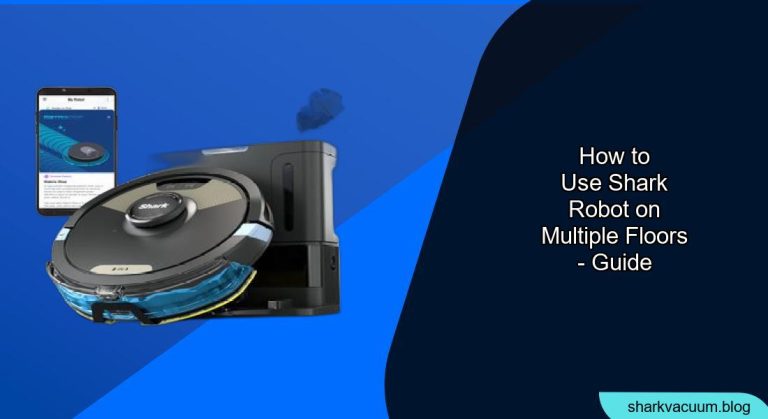Navigating a multi-story home with a robot vacuum can seem daunting, but with the right approach, your Shark robot vacuum can efficiently clean all your floors. This guide will walk you through the steps to successfully use your Shark robot on multiple levels, ensuring a consistently clean home.
Why Use a Robot Vacuum on Multiple Floors?
Using a robot vacuum on multiple floors saves time and effort compared to manually vacuuming each level. It ensures consistent cleaning, reaching under furniture and into corners that are often missed. By automating this chore, you can focus on other tasks, maintaining a cleaner home with minimal personal involvement.
Table of Contents
Preparing Your Shark Robot for Multi-Floor Cleaning

Before you can effectively use your Shark robot on multiple floors, some initial setup is required.
1. Initial Mapping and Setup
The first step is to ensure your Shark robot has properly mapped each floor of your home.
- Charge the Robot: Fully charge your Shark robot before the initial mapping run.
- Clear Obstacles: Remove any clutter, cords, or small objects that could obstruct the robot’s path.
- Initial Mapping Run: Place the robot on the floor you want to map first and start a cleaning cycle. Allow it to explore and create a map of the entire floor.
- Save the Map: Use the SharkClean app to save the map once the cleaning cycle is complete. Give each map a descriptive name (e.g., “First Floor,” “Second Floor”).
2. Setting Up Multiple Docks (Optional)
For optimal performance, consider setting up a charging dock on each floor.
- Purchase Additional Docks: If your Shark robot didn’t come with multiple docks, you can purchase additional ones from the Shark website or authorized retailers.
- Placement: Place each dock in a central, easily accessible location on each floor. Ensure there is enough clear space around the dock for the robot to maneuver.
- Power Supply: Connect each dock to a power outlet and ensure it is properly functioning.
3. Using No-Go Zones and Boundary Strips
Protect delicate areas and prevent the robot from accessing unwanted spaces.
- Identify Problem Areas: Determine areas where you don’t want the robot to go, such as pet feeding stations, areas with fragile items, or stairs (if you’re not using floor detection).
- No-Go Zones (App): Use the SharkClean app to set up virtual “no-go zones” on each floor’s map.
- Boundary Strips (Physical): For areas that are difficult to map precisely, use physical boundary strips to create a barrier. Place the strips on the floor to block the robot’s path.
Cleaning Each Floor
With the setup complete, you can now efficiently clean each floor of your home.
1. Moving the Robot
When moving the robot between floors, follow these steps:
- Power Off: Turn off the robot before physically moving it to prevent accidental starts.
- Carry Safely: Lift the robot by its body, avoiding the dustbin and other detachable parts.
- Placement: Place the robot in the center of the floor you want to clean.
2. Selecting the Correct Map
It’s crucial to select the correct map in the SharkClean app for the floor you’re cleaning.
- Open the App: Launch the SharkClean app on your smartphone or tablet.
- Select Floor: Navigate to the map selection menu and choose the map corresponding to the current floor (e.g., “Second Floor”).
- Start Cleaning: Once the correct map is selected, start the cleaning cycle.
3. Monitoring and Assistance
While the robot is cleaning, occasional monitoring may be needed.
- Listen for Issues: Pay attention to any unusual noises or behavior from the robot.
- Unstuck the Robot: If the robot gets stuck, gently free it and resume the cleaning cycle.
- Empty the Dustbin: Regularly empty the dustbin, especially after cleaning a large area or a particularly dirty floor.
Advanced Tips for Multi-Floor Cleaning
Enhance your multi-floor cleaning routine with these advanced tips.
Scheduling Cleanings
Set up a cleaning schedule for each floor to maintain cleanliness effortlessly.
- Create Schedules: Use the SharkClean app to create a cleaning schedule for each floor.
- Stagger Cleanings: Schedule cleanings for different floors on different days to prevent the robot from being overworked.
- Custom Cleaning Modes: Utilize custom cleaning modes for different floors based on their specific needs (e.g., “Max” mode for high-traffic areas).
Using Voice Control
Control your Shark robot with voice commands for added convenience.
- Connect to Voice Assistant: Link your SharkClean account to your preferred voice assistant (e.g., Amazon Alexa, Google Assistant).
- Voice Commands: Use voice commands to start, stop, or pause cleaning cycles, and to send the robot back to its dock.
Maintenance
Regular maintenance ensures your Shark robot operates efficiently and lasts longer.
- Clean Brushes: Regularly clean the brushes to remove hair, debris, and tangled fibers.
- Replace Filters: Replace the filters every few months to maintain optimal suction power.
- Check Sensors: Wipe the sensors with a soft cloth to ensure accurate navigation.
Troubleshooting Common Issues
Address common problems to keep your Shark robot running smoothly.
1. Robot Not Returning to Dock
- Ensure Clear Path: Make sure there are no obstacles blocking the robot’s path to the dock.
- Check Dock Placement: Verify the dock is placed in a central, easily accessible location.
- Clean Charging Contacts: Clean the charging contacts on both the robot and the dock.
2. Robot Getting Stuck
- Identify Problem Areas: Note where the robot frequently gets stuck and address the issue.
- Use No-Go Zones: Set up no-go zones in the app to prevent the robot from entering problematic areas.
- Remove Obstacles: Clear any small objects or cords that could trap the robot.
3. Poor Cleaning Performance
- Empty Dustbin: Ensure the dustbin is not full.
- Clean Brushes and Filters: Regularly clean the brushes and replace the filters.
- Check Suction Power: Verify the suction power is set to the appropriate level for the floor type.
FAQ Section
How does the Shark robot handle stairs?
Shark robots typically have cliff sensors that prevent them from falling down stairs. However, it’s always best to use boundary strips or no-go zones to ensure they don’t approach the edge.
Can I use the same map for multiple floors if they have the same layout?
While you can try, it’s generally better to create separate maps for each floor to account for slight variations in furniture placement and room dimensions. This ensures more accurate cleaning.
What do I do if my robot gets lost between floors?
If your robot gets lost, manually return it to its dock on the floor it last cleaned. It will eventually reorient itself. You can also use the “Find My Robot” feature in the app, if available.
How often should I clean the brushes and filters?
It’s recommended to clean the brushes every 1-2 weeks and replace the filters every 2-3 months, depending on usage and the amount of dirt and debris in your home.
Can I use the Shark robot on hardwood floors and carpets?
Yes, Shark robots are designed to work on both hardwood floors and carpets. Most models have adjustable suction power and brush settings to optimize cleaning performance on different floor types.
What is the best way to maintain the battery life of my Shark robot?
To maximize battery life, always fully charge the robot before its first use, avoid running it continuously for extended periods, and store it in a cool, dry place when not in use.
Tips, Warnings, and Best Practices
- Safety First: Always supervise the robot during its initial cleaning cycles on each floor.
- Regular Maintenance: Stick to a regular maintenance schedule to keep your robot in top condition.
- Floor Type Settings: Adjust the cleaning settings based on the floor type for optimal performance.
- Avoid Wet Areas: Do not use the robot to clean wet areas or spills.
- Secure Cords: Always secure loose cords to prevent the robot from getting tangled.
Conclusion
Using your Shark robot vacuum on multiple floors is a convenient way to maintain a consistently clean home. By properly preparing your robot, setting up multiple docks if needed, and following the guidelines for cleaning each floor, you can automate your cleaning routine and enjoy a cleaner living space with minimal effort. Embrace the convenience and efficiency of your Shark robot to make multi-floor cleaning a breeze.







